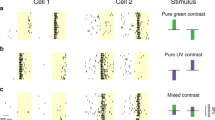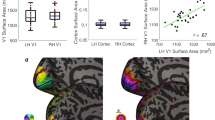Abstract
The ability of human observers to detect Vernier breaks of as little as 5s of arc has been termed hyperacuity1 as this distance is substantially less than the angular separation of the bars of the highest spatial frequency of grating (˜1 arc min) that can be detected. Although the visual cortex is a likely candidate for the location of detectors involved in this performance2, it is not known whether there are cells sensitive enough to detect deviations from co-linearity that are small compared with their spatial resolution (defined in terms of the highest spatial frequency that the cell can detect). We report here the results of physiological experiments on single units in area 17 of the cat visual cortex in which we studied the effect of introducing a Vernier break into a bar stimulus moved across the receptive field of the cell at a constant velocity. Our results show that the responses of most simple and complex cells are significantly reduced by the introduction of a Vernier break that is substantially smaller than the spatial resolution of the cell. The most sensitive cells in our sample could discriminate Vernier offsets of 3–6 arc min with a reliability of ˜70%. This was much smaller than their spatial resolution, which was in the range 25–30 arc min. We interpret these results in terms of mechanisms that could underly the orientation selectivity of cortical neurones and suggest how our results relate to human Vernier acuity.
This is a preview of subscription content, access via your institution
Access options
Subscribe to this journal
Receive 51 print issues and online access
$199.00 per year
only $3.90 per issue
Buy this article
- Purchase on Springer Link
- Instant access to full article PDF
Prices may be subject to local taxes which are calculated during checkout
Similar content being viewed by others
References
Westheimer, G. Prog. Sens. Physiol. 1, 1–30 (1981).
Berkley, M. A. & Sprague, J. M. J. comp. Neurol. 187, 679–702 (1979).
Cynader, M. S., Mustari, M. & Gardner, J. C. Expl Brain Res. 53, 384–399 (1984).
Parker, A. J. & Hawken, M. J. opt. Soc. Am. 2, 1101–1114 (1985).
Watt, R. J., Morgan, M. J. & Ward, R. M. Vision Res. 23, 991–995 (1983).
Andrews, D. P. Vision Res. 7, 975–1013 (1967).
Sullivan, G. D., Oatley, K. & Sutherland, N. S. Percept. Psychophys. 12, 438–444 (1972).
Andrews, D. P., Butcher, A. K. & Buckley, B. R. Vision Res. 13, 599–620 (1973).
Barlow, H. B. Nature 279, 189–190 (1979).
Crick, F. H. C., Marr, D. C. & Poggio, T. in The Organisation of the Cerebral Cortex (ed. Schmitt, F. O.) 505–533 (MIT Press, 1980).
Cleland, B. G., Harding, T. H. & Tulunay-Keesey, U. Science 205, 1015–1017 (1979).
Mitchell, D. E., Murphy, K. & Kaye, M. Invest. Opthal. 25, 908–917 (1984).
Author information
Authors and Affiliations
Rights and permissions
About this article
Cite this article
Swindale, N., Cynader, M. Vernier acuity of neurones in cat visual cortex. Nature 319, 591–593 (1986). https://doi.org/10.1038/319591a0
Received:
Accepted:
Issue Date:
DOI: https://doi.org/10.1038/319591a0
This article is cited by
-
Perceived geometrical relationships affected by eye-movement signals
Nature (1997)
-
Neurophysiological correlates of perceptual learning in the human brain
Brain Topography (1994)
-
Hyperacuity and the visual cortex
Nature (1987)
Comments
By submitting a comment you agree to abide by our Terms and Community Guidelines. If you find something abusive or that does not comply with our terms or guidelines please flag it as inappropriate.



